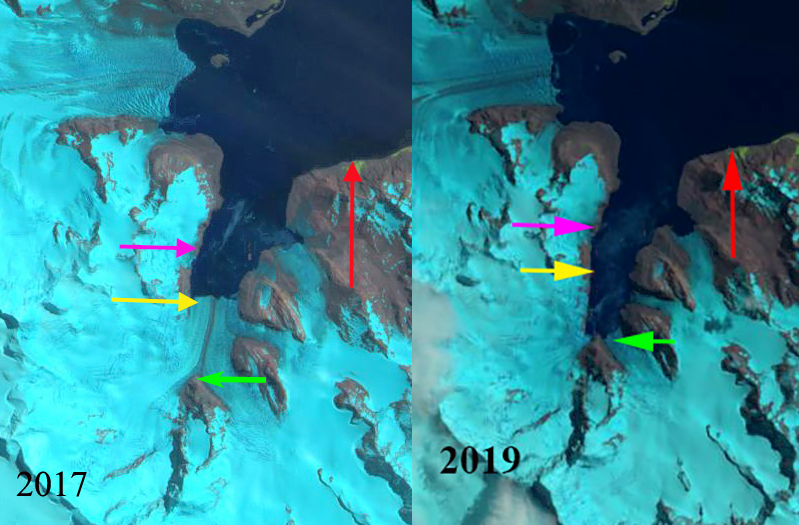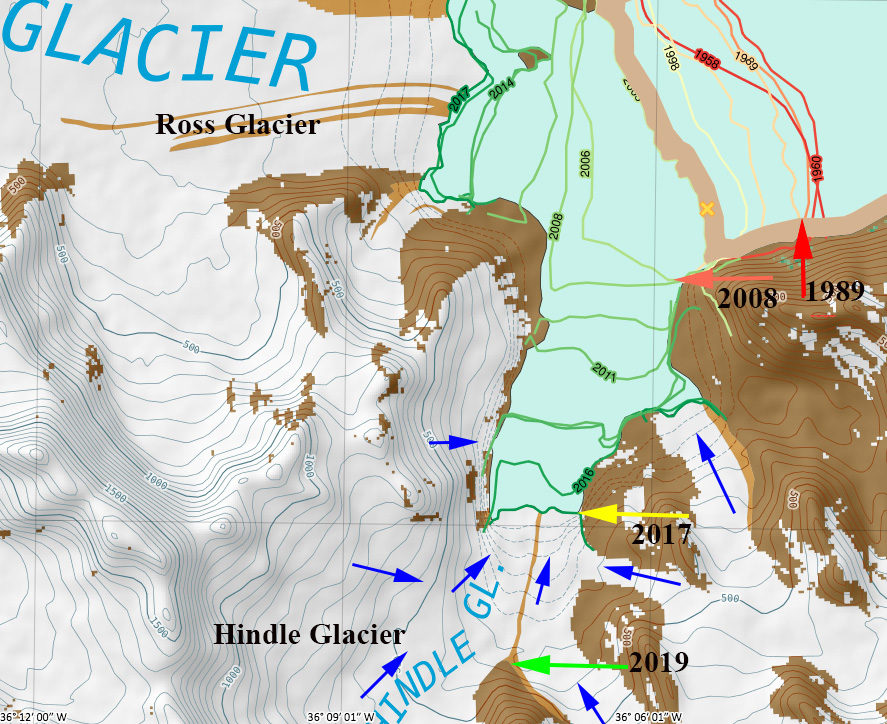February 22, 2019
Hindle Glacier Retreat, South Georgia 2 km 2015-2019
Posted by Mauri Pelto
Hindle Glacier comparison in 2017 and 2019 Landsat images. Red arrow is 1989 terminus, pink arrow the 2015 terminus, yellow arrow the 2017 terminus location and green arrow the 2019 terminus location.
South Georgia is south of the Polar Front preventing any truly warm season, with the cool maritime climate leading to numerous glaciers covering a majority of the island. Hindle Glacier enters Royal Bay on the east coast of South Georgia Island. The British Antarctic Survey (BAS) has been the principal research group examining glacier change on South Georgia Island. Cook et al (2010) and Gordon et al (2008) noted a pattern island wide with many calving glaciers having the fastest retreat. Gordon et al., (2008) observed that larger tidewater glaciers remained in relatively advanced positions from the 1950’s until the 1980’s, followed by significant recession. Alison Cook at British Antarctic Survey identified that 212 of the Peninsula’s 244 marine glaciers have retreated over the past 50 years and rates of retreat are increasing. In 2017 we examined Landsat imagery from 1989 to 2017 to identify the rapid retreat rate. NASA Earth piggy backed on this assessment, with excellent imagery, since the retreat rate has increased. Here we update the retreat with 2019 Landsat images.
For Ross-Hindle the retreat was minimal from 1960 to 1989 with the glaciers joined In 1989 the glaciers joined 2.5 km from the terminus. The glacier spanned Royal Bay with a 3.2 km wide calving front. By 2002 the glacier front had retreated 800 m, but they were still joined. By 2008 the glaciers had separated due to an additional retreat of 1.4 km. The front was now retreating south up a separate embayment from Ross Glacier. The calving front in 2008 was 1.6 km wide. By 2015 further retreat led to the separation of Hindle from an eastern tributary at the first prominent headland in the fjord, a 1.6 km retreat in seven years. By 2017 an additional 600 m of retreat had occurred. From 2017 to 2019 the terminus retreated another 1.5 km back to a prominent rock knob separating the two main tributaries of the glacier with total retreat of 6.1 km in 30 years. This is a rate of over 200 m/year, which is an exceptional rate. Over the 2015-2019 period the glacier retreaeted over 2 km, more than 500 m/year. The western tributary appears to be at the head of the fjord, while the eastern tributary has another 1 km to an increase in slopes that likely is close to head of the fjord. The new fjord is 4.5 km long and averages 1.1 km in width. This embayment will open up new areas for Gentoo Penguins and elephant seals to immigrate into. Levy et al (2016) discuss the shift and dispersal of colonies in the region, that climate change is an important driver of.
Map of terminus retreat of Ross and Hindle Glacier from the BAS. Green Pin Locations are Gentoo Penguin colonies.
Hindle Glacier comparison in 1989 and 2015 Landsat images. Red arrow is 1989 terminus, pink arrow the 2015 terminus, yellow arrow the 2017 terminus location and green arrow the 2019 terminus location.





 Dean of Academic Affairs at Nichols College and Professor of Environmental Science at Nichols College in Massachusetts since 1989. Glaciologist directing the North Cascade Glacier Climate Project since 1984. This project monitors the mass balance and behavior of more glaciers than any other in North America.
Dean of Academic Affairs at Nichols College and Professor of Environmental Science at Nichols College in Massachusetts since 1989. Glaciologist directing the North Cascade Glacier Climate Project since 1984. This project monitors the mass balance and behavior of more glaciers than any other in North America.